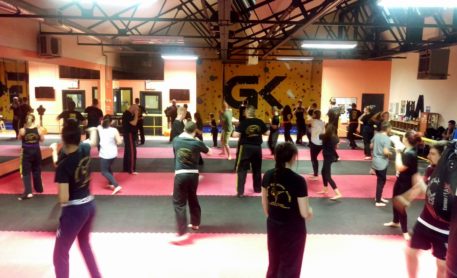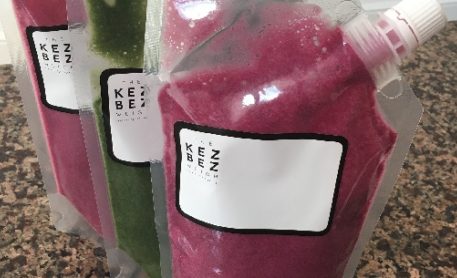
Training Offered
- Join Us Today
- Lead Instructors
- Senior Instructors
- Assistant Instructors
- Medical Doctor
- Club Attire
- Ladies Kickboxing Leeds
- Practical Self Defence Leeds
- Gradings Leeds 2025
- Gradings Black Belt Leeds
- Contact Sparring
- Combat Academy
- Champions Wall
- Private Coaching Leeds
- Remote Personal Training Leeds
- Online Training Leeds
- Gym Access
- Gym Space Hire Leeds
- Faqs
Latest Posts
8
Oct
A KICKBOXER’S DIET
By: Kerry Berry nutrition, diet, health

Is a kickboxer’s diet different to any other diet?
In this blog, I’ve been asked to write about a kickboxer’s diet. Of course! I said. It will definitely be of interest to you guys. But it got me thinking. Is a kickboxer’s diet different to any other diet? Let’s explore.
WHAT DOES "DIET" ACTUALLY MEAN?
We should really start with what a diet actually means. Here is a basic dictionary definition: “A selection of foods & drink eaten by a particular person or group”. This will have different meanings to different people. Personal choice, food preference, lifestyle, religion & cultural beliefs, social norms & etiquette and environmental factors, all influence our choice of diet. Our choice & preference can also change over time.
Any diet you wish to pursue, contain food and drink considered in terms of qualities, composition and overall effects on health. To delve into a discussion on the benefits of any particular diet (vegetarian, paleo, vegan, low carb, high protein, high fat, etc.), is another blog entirely!
So lets talk more about the qualities, composition and overall effect on health your diet should have. The food we consume contains protein, fats, carbohydrates, vitamins, minerals, phytochemicals, zoochemicals, water, fibre and many more compounds important to our overall health, in varying amounts. Food provides the nutrition our body needs to look, feel and perform at our best.
A Kickboxer's Diet
The best diet for a kickboxer is not a straightforward answer. Body type, body composition, fitness and activity level, dietary preferences, budget, ethnic background, age & gender all contribute to what your body needs and what you view as good nutrition.
Having said that, we can discuss the general needs of someone who trains regularly in the sport of kickboxing. A sports such as kickboxing, is fast and explosive. Your body relies upon the glycolytic pathways for energy transfer to match the explosive nature of kickboxing.

But no one needs a science lesson, so we’ll leave the fancy stuff here! Basically, your body will rely on glucose, (sugar), for energy during training sessions. I am not saying you need to run out & stock up on bags of sugar to get you to black belt status! Keep reading!
The body breaks down the carbohydrates, (carbs) you eat into its simplest form (glucose), to be used for the energy you need to fuel your training sessions. The quality and type of carbs you eat will make a huge difference to the way you feel and how well you perform. Not all carbs are created equally. It’s important to include good quality carbs in your diet. Foods such as: vegetable, fruit, whole grains, beans brown rice and lentils. Highly processed carbs such as pasta and bread should be eaten in their whole grain form, i.e. wholemeal bread & wholewheat pasta. These foods are better with nowt taken out! How much do you need? There really isn’t a correct amount and a best guess will depend on body size, lean body mass, activity level, intensity of activity, age, genetics, food preference and specific goals. Our brain alone needs around 130g of glucose per day, so it is important to include carbs in your diet.
If you want to cut back on carbohydrate foods, which seems to be the trend, you would do well to look at the quality of the foods you eat. Rather than cutting out food groups, which I would never advocate, (unless medically indicated), increase the quality of food sources instead. For example, if you want to reduce the amount of bread & pasta in your diet because it doesn’t make you feel too good, replace it with more fresh vegetables at meal times, beans, legumes and fruit as a sweet treat. You’ll still be providing your body with its preferred energy source, while reducing the amount of processed food you are eating. Win –Win. Carbohydrates are not the devil. Eat them, you need them. The last thing you want to happen is brain fog when David invites you to a sparring session!!
So you’ve got your carbohydrates cleaned up. You’re performing well and have tonnes of energy to take on whoever dares to challenge you. All that wear and tear on your muscles needs your attention. The macronutrient to help you with this job is protein. It’s not just your muscles that need protein. Our body uses protein up constantly for nearly every metabolic activity. Unlike carbs and fats, we cannot store protein in the same way so we need to eat enough protein every day to meet demand. The body’s demand for protein is increased in those who are physically active – you lovely lot fall into this category. Protein can be found in almost all food. All the lovely extra fresh veg you’re now eating will count too. High protein food sources include things like meat, chicken, game meats, eggs, fish & seafood, beans, lentils, yogurt, cottage cheese, tofu and protein supplements.
WE DON’T EAT NUMBERS. WE EAT FOOD.
There are all sorts of complicated math formulas I could share with you to help you work out how much protein you should be consuming. But in reality, we don’t eat numbers, we eat food. My preferred method is simpler. Aim to get some form of lean protein at every meal. I have a hand guide to demonstrate portion size. Its simple, its easy with a little practice and you can do it wherever you are having a meal. No maths required. Basically, the size of your palm is used to determine your protein portion size. Have one palm-sized portion at every meal if you are a female, two if you are a male. Simple! NB: Women are more likely to eat too little protein so check your intake ladies. With your muscles nicely nourished and your energy levels soaring, what else could you possibly need?
Fat. Another trend that needs putting right. Low fat diets are not necessarily conducive to good health. Fat is important. We need fats to form our brain and nervous system, our cell membranes, help us to make and balance hormones, transports fat soluble vitamins, give us energy and it makes food taste good! What needs to be taken into consideration is the type of fats we are consuming. We need a balance and mix of different types of fats that occur naturally in different types of foods. For instance, nuts, seeds, avocado, diary foods, eggs, fatty fish, meat, poultry, olives & olive oil. All contain fats. Some of these foods are higher in saturated fats, some are highest in mono/poly unsaturated fats. Don’t get bogged down in the detail, all fats are needed by the body. Contrary to popular belief, naturally occurring saturated fats are not harmful. The key here is to focus on eating NATURAL fats from natural foods as much as possible.
The types of fat you need to think about limiting are processed trans-fats. Trans fats come from industrial fat processing. A process known as hydrogenation, brought into use to increase the shelf life of fats and the foods containing those fats. Think burgers, sausages, pies, pastries etc. They do nothing good for you or your health.
In practical terms, if the food you are eating comes out of a packet or box with a list of ingredients as long as your arm, my guess is you’re getting your daily fat intake from trans fats along with all of the extra additives like salt and refined sugars manufacturers like to throw into the mix.
A slight word of caution. 1g of fat contain 9kcals, that’s nearly twice as many calories per gram than protein or carbohydrate so portion size is important. It could be a lot smaller than you think.
FAT PORTIONS.
A simple way to estimate fat portion is to look at your thumb. A portion of fat is around the size and thickness of your thumb, which, if you weighed it would be around 25g-30g. So if you’re eating avocado with your salad – amazing! But if you’re eating the whole avocado with your salad, not so amazing.
Leaving the sums to the mathematicians, the easy way to estimate your fat intake is include one thumb sized portion of naturally occurring fat at most meals for females, two for males. It is very easy to over eat fat. It tastes so good for one thing! We can also easily forget that we cooked the chicken in coconut oil, added a big dollop of butter to a jacket potato, and then stacked it with grated cheese. Can you guesstimate how many fat portions we’ve just put into one meal?
WATER & SWEAT.
When leaving the gym, there is always one thing that we all leave behind. Sweat. We all sweat, some more than others. Lack of fluid intake and poor hydration levels are a common problem I see crop up time & time again with the clients I work with. How much water you need is very much dependent on your body size. The recommended daily intake of 8 glasses per day will work for me but won’t touch the sides if you weigh 95Kg. Generally, we need 30-40mls of water per Kg of body weight. We have an extremely useful in built regulator to help us with this. Thirst. Our body regulates our thirst so that we take in more fluid when we need it.
Having said that, there may be a bit of lag time between losing fluid and feeling thirsty. So don’t wait until you’re thirsty to grab a drink. My recommendation would be to drink a glass of water before each meal. This should mean you’d be drinking 3-4 glasses more than you were previously.

It’s also a good idea to pay attention to how many times you urinate and the colour of your urine. If you are well hydrated, you should be going to the toilet at least 5 times a day and your urine should be clear or a light straw colour. We are constantly losing water. You’re losing water while sitting reading this, simply by breathing. Keeping topped up is essential. It also helps with fatigue, headaches and concentration.
On top of the general recommendation, when you take part in moderate intensity training, you should consume ½-1 litre of fluid during the activity and again afterwards to combat any dehydration risk. Your aerobic and muscular endurance can be impaired from losing as little as 1-3% body water loss. A brief note on sports drinks. For the average person, plain water is just fine. But in some situations, sports drinks could be a consideration, including: endurance athletes, high intensity training, multiple daily training sessions or when in hot/dry climates. In general terms, keep topped up with good old-fashioned water and you won’t go too far wrong. Top tip: ask for tap water when you’re out. No extra calories and it’s free!
SO? IS A KICKBOXER’S DIET DIFFERENT TO ANY OTHER TYPE OF DIET?
We have already said that a diet is a way of eating that suits your lifestyle, cultural beliefs and social norms. Any diet should include foods that you like, provide enough energy to fuel your activities/training needs, support growth and repair, satisfy hunger and make you feel good. Essentially, my answer is, not really. Good nutrition works across the board. Get the basics right and you will feel good and perform better in any given sport. Maybe you were hoping for subjects like meal frequency, nutrient timing, sports supplements and macro ratios to be discussed?
Without working on the fundamentals of good nutrition, none of the above will make a blind bit of difference. NB: If you already have all this worked out, then it could help to improve performance.
PRACTICAL TIPS
So my EKA friends and friends of friends, here are some practical tips to take away: Use the simple hand guide I mentioned to help you work out the appropriate portion size. Start with your protein intake. My guess will be that you will not be eating enough and this may need increasing. Add in some natural healthy fats; be careful on the portion size, as you’re probably eating too much. Fill up with quality carbohydrates, main focus being on fresh veg, fruits, beans, lentils, brown rice, wholewheat bread & pasta, to fuel your workouts and feed your brain. Don’t wait until you feel thirsty to have a glass of water. Make sure you bring a drink with you to your sessions – no excuses here as David has a fridge stocked up with water bottles.
KEZ BEZ WEIGH - SUPER SMOOTHIES

If you want a hassle free start to improving your nutrition one meal at a time, check out the new freezer at the club. There is where you’ll find my smoothies, lovingly made up and ready for you to enjoy. They are a perfect balance of protein, fats, carbs, vitamins, minerals & fibre. Just what your body is craving after a tough workout.
But you’ll know that from reading my previous blogs, right? To put all this into practice in the real world, I can help. The KEZBEZ WEIGH is a one to one, personalised approach to weight management. I won’t just tell you what you need to know to improve your nutrition. I will show you HOW to eat better, starting with where you are right now and by finding the solutions you need to move forward.
For more information get in touch through the Elemental Fitness contact page!



